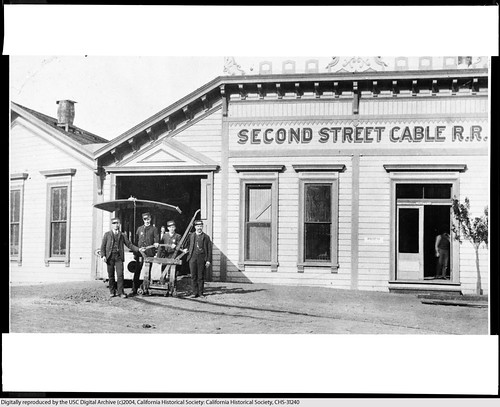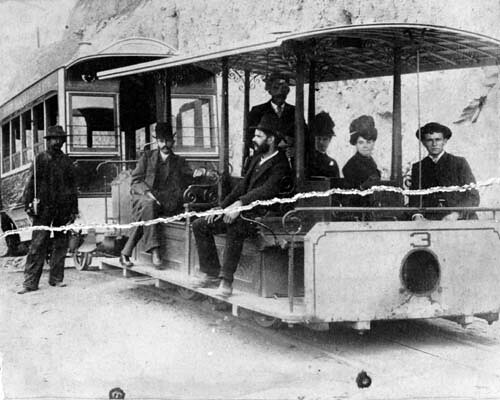
Many an Angeleno has heard of the legendary Pacific Electric Railway, or Red Car system which transported passengers to locations well beyond the city limits. Those who have brushed up on their local history are probably familiar with The Los Angeles Railway (LARy), aka the Yellow Cars, whose routes journeyed within city line. However, most are probably unaware that the City of Angels briefly sported a couple of good old fashioned cable car lines that ran right through Bunker Hill. The first cable line to maneuver the hills of Downtown ran along Second Street, delighted travelers, and lead to the westward expansion of the city. Despite its fantastic success, the Second Street Cable Railway survived for only a short period of time.
During the real estate boom of the 1880s, the area just west of Downtown was what the newspapers referred to as a “howling wilderness,” largely because the hilly terrain rendered navigation by horse drawn carriage virtually impossible. This slight obstacle did not discourage local land owners who sought to make the area attractive for development. By this time, the cable cars in San Francisco had been successfully operating for over a decade and some enterprising businessman began to consider this mode of transportation as a solution to Mother Nature’s challenges.

Plans for two separate cable lines sprang up at the same time, but the Second Street Cable Railway Company was always a step ahead of the alternate line which would eventually run up Temple Street. Land owners with holdings west of the city provided much of the capital for the Second Street Line, along with business owners on Spring Street near Second, who hoped convenient transportation would boost retail in the area. Some of the main backers and promoters of the railway company included Edward A. Hall, Henry Witmer, I.W. Lord and John Hollenbeck. Lord, who would later found the city of Lordsburg (now La Verne) broke ground on the project, and the first tracks for the new cable line were laid at the intersection of Second and Hill on the morning of April 27, 1885. Five days later the first advertisements promoting real estate near the proposed line began appearing in the local newspapers.

Construction on the line continued at breakneck speed, which was no small task considering pieces of hillside were cut and removed at some parts of the line. The Second Street Cable Railroad was completed in the early fall and made its inaugural trip at 4:05pm on October 14, 1885. The line ran approximately 6,770 feet, or a mile and a quarter, up Second Street and through Bunker Hill from Spring to Belmont. A one way trip took between twelve and fourteen minutes and the line was open from 6am to 11pm. At its steepest, the cable cars ran over the hills of Los Angeles at a twenty seven percent grade between Hope Street and Bunker Hill Avenue. The total cost to construct the line was roughly $100,000.

The Second Street Cable Railway was an immediate success and did indeed spark development on the land west of Bunker Hill. Investors originally expected the line to serve around six hundred people a day, but by the end of 1886, the cable cars were carrying more that three times that number. In January 1887, Edward Hall and Henry Witmer, President and Treasurer of the Second Street Cable Railway Company, decided to get out when the getting was good. They sold their company shares to James M. McLaughlin for $130,000 and he became the primary owner of the Second Street Cable Railway.

McLaughlin had ambitious plans to connect Downtown with the area that would eventually become Hollywood, by connecting the cable railway with a steam line called the Cahuenga Valley Railroad. The plans turned sour when the Cahuenga Valley Railroad was barred from operating within the city limits because of the noise and air pollution. McLaughlin’s attempts to get the Second Street Line extended soon failed. Add to this the end of the boom times and McLaughlin soon found himself and his company in the red. By the end of 1889, McLaughlin was virtually bankrupt and the line stopped running while legal matters were straightened out. That winter, torrential rains severely damaged portions of the line and by early 1890 McLaughlin had lost the company, and the first cable line of Los Angeles was permanently abandoned.
Photos courtesy of the Los Angeles Public Library Photo Collection and the USC Digital Archive

